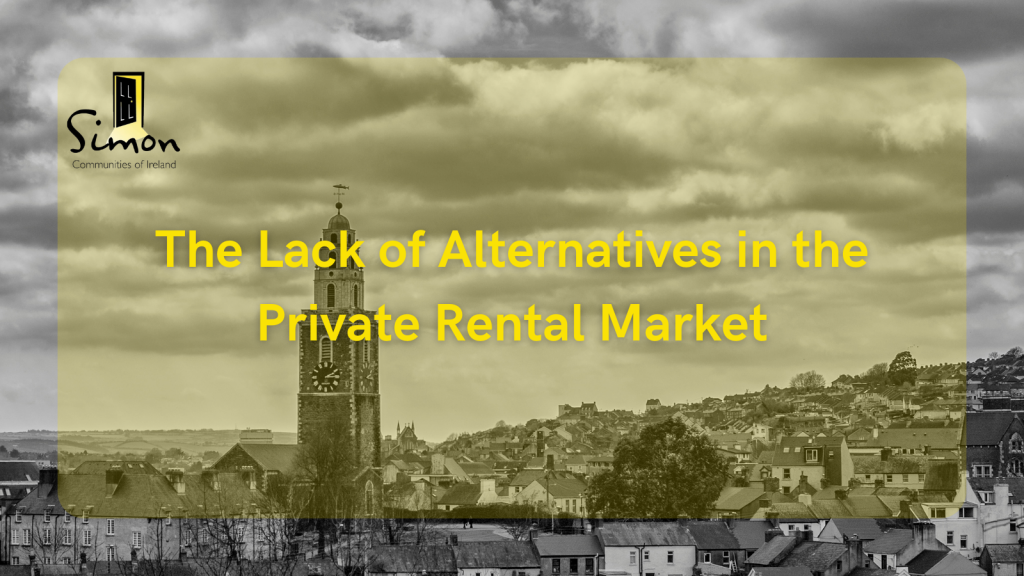Author: Rebecca Hamilton

This is the second of a series blogs, the first of which explored eviction notices. This blog explores the lack of alternatives in the private rental sector (PRS) for people who receive eviction notices and how the declining availability of properties in the sector has resulted in less people exiting or being prevented from entering emergency accommodation through the PRS. The final blog of this series will explore the over-reliance on the private rental sector to provide social housing through allowances such as HAP and RAS.
The Lack of Alternatives
We are currently experiencing an extreme lack of affordable homes in Ireland. Despite positive steps being made, including the introduction of the cost-rental tenure and the tenant-in-situ scheme, there is simply nowhere near enough housing available to keep pace with current demand. Simon Communities of Ireland’s latest Locked Out of the Market study found the lowest number of available properties within standard or discretionary HAP limits since the series began. Out of the few available properties on the market, just 27 (3%) of properties were available nationwide within HAP discretionary limits.
The latest Daft.ie rental report from Q3 2023 found just under 1,800 homes available to rent across the country (the report estimated that the need is approximately 6,000). 4,518 households received notices of termination from their landlord over the same period. This highlights an obvious issue. There is a severe lack of alternatives in the private rental market for households issued with eviction notices. Undoubtedly, a number of these households are, and will continue to be, pushed into homelessness and hidden homelessness.
What is Happening in the Private Rental Sector?
As is well documented across the media, in recent times a number of landlords have sold their properties and left the private rental market. This is often termed as an ‘exodus of landlords from the market.’. Research from the RTB shows the proportion of small, medium and large landlords who intend to leave the market in the coming years has increased. For small landlords (1-2 properties), 27% of properties are likely/very likely to be sold within the next five years. For medium landlords, who own 3-99 properties, 26% are likely/very likely to sell a property in the next 12 months, in addition to 29% and 37% within the next two and five years respectively. For large landlords (100+ properties) the situation is similar. Most large landlords are not optimistic about their future in Ireland, threatening their long-term commitment to the sector.
14,845 (62%) of the 24,076 notices of terminations issued by landlords since Q3 2022 are due to the landlord intending to sell the property.
The impact of this is a reduction in the number of properties available to rent and increases in the cost of securing a home in the private rental market. This in turn means that less and less households are exiting homelessness into the PRS. This is displayed clearly in the graph below. Exits and preventions from emergency accommodation through the PRS have decreased from 4,022 in 2020 to just 2,119 so far this year.
Although total exits and preventions through Local Authority (LA) lets, along with Approved Housing Body (AHB) lets and Long-Term Supported Accommodation have increased (see table below), the increase is not significant enough to make up for the loss of exits and preventions through the PRS. Therefore, we continue to call on the government to increase it’s social housing targets to at least 15,000 social homes per year. It is imperative that the constrained supply in the PRS is counteracted with a significant increase in the supply of social and affordable homes in order to prevent homelessness and housing insecurity.
It is noted that in 2020 and 2021, additional rental properties were available in the PRS due to the collapse of tourism during the pandemic. This meant that a number of properties that were previously being let out as short-term tourist accommodation were let out on the long-term private rental market during this period. The return of some these properties to the short-term tourist rental market along with the large number of landlords leaving the market can be attributed as significant contributing factors to the lack of alternatives on the private rental market.
It can be concluded from this analysis that the affordability and supply issues in the private rental market are having a significant impact on people experiencing homelessness, making it much more difficult for them to exit homelessness, and avoid becoming homeless in the first instance. The final blog of this series will explore the over-reliance on the PRS to provide social housing through allowances such as HAP and RAS. As is well documented, this is putting significant pressure on the private rental sector. We explore potential solutions to this in the next and final blog of this series.


